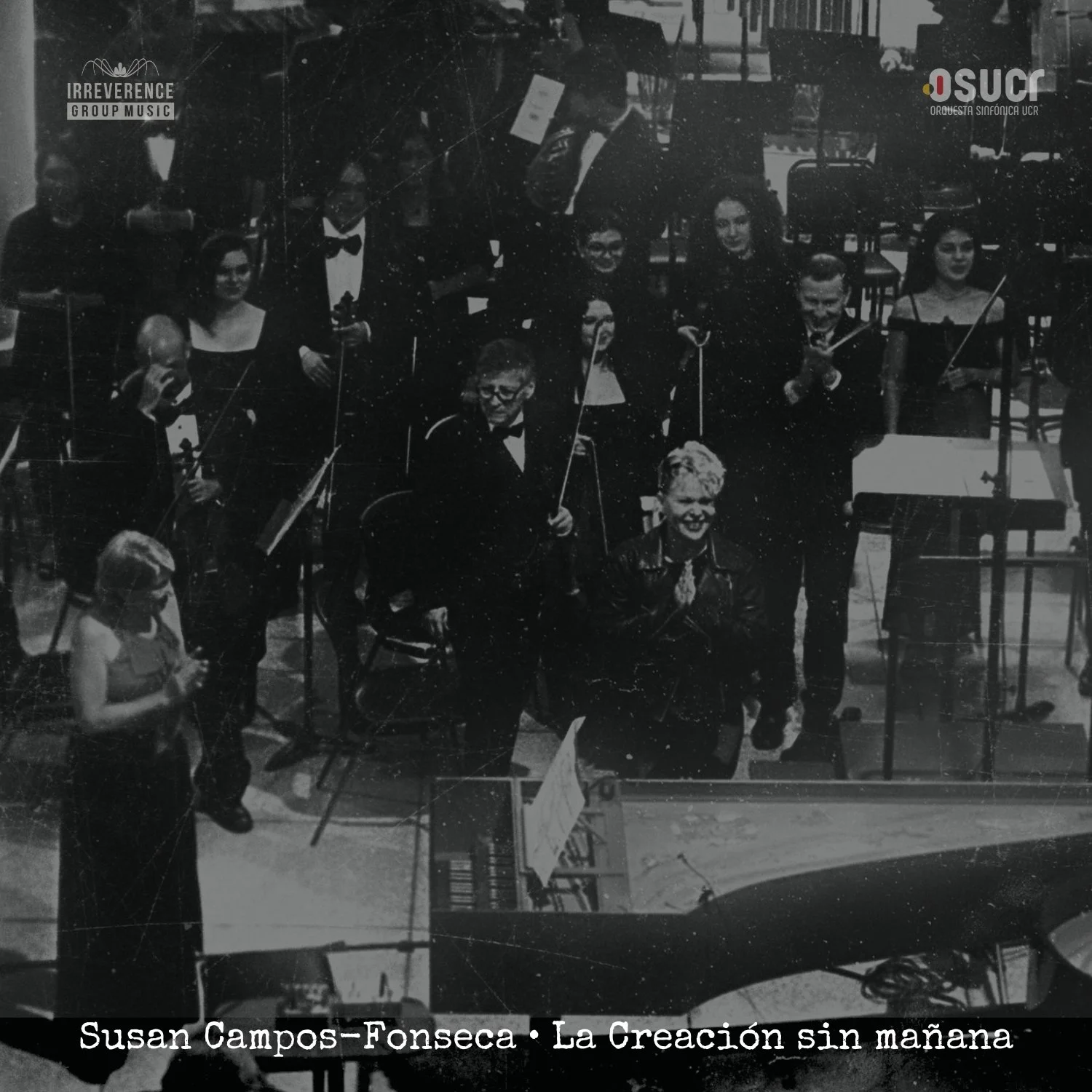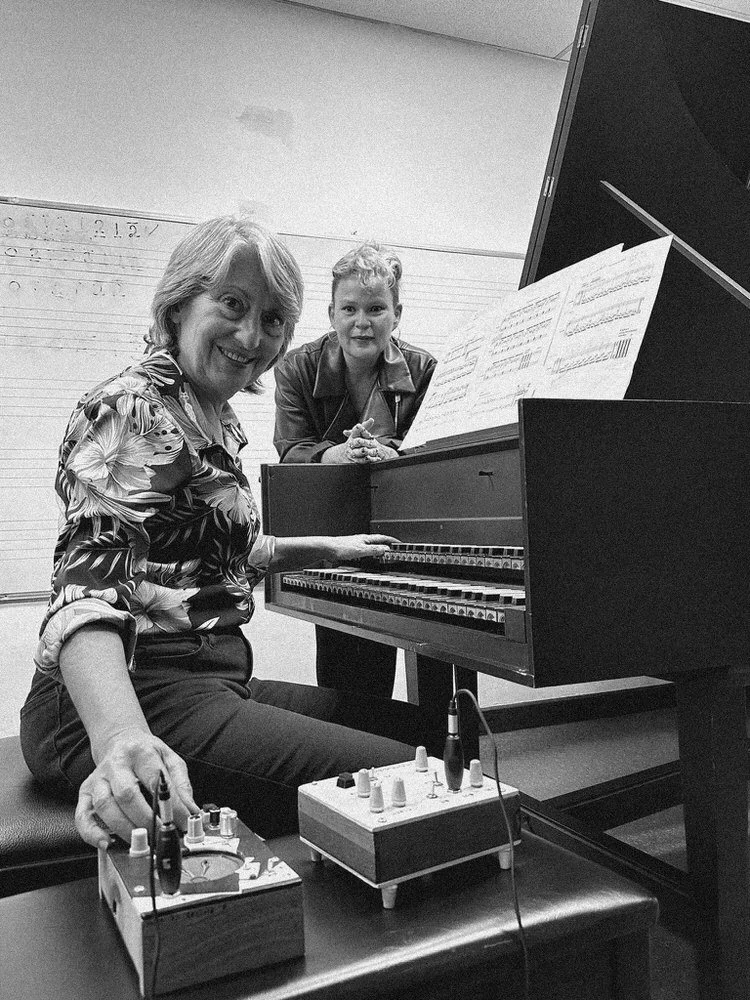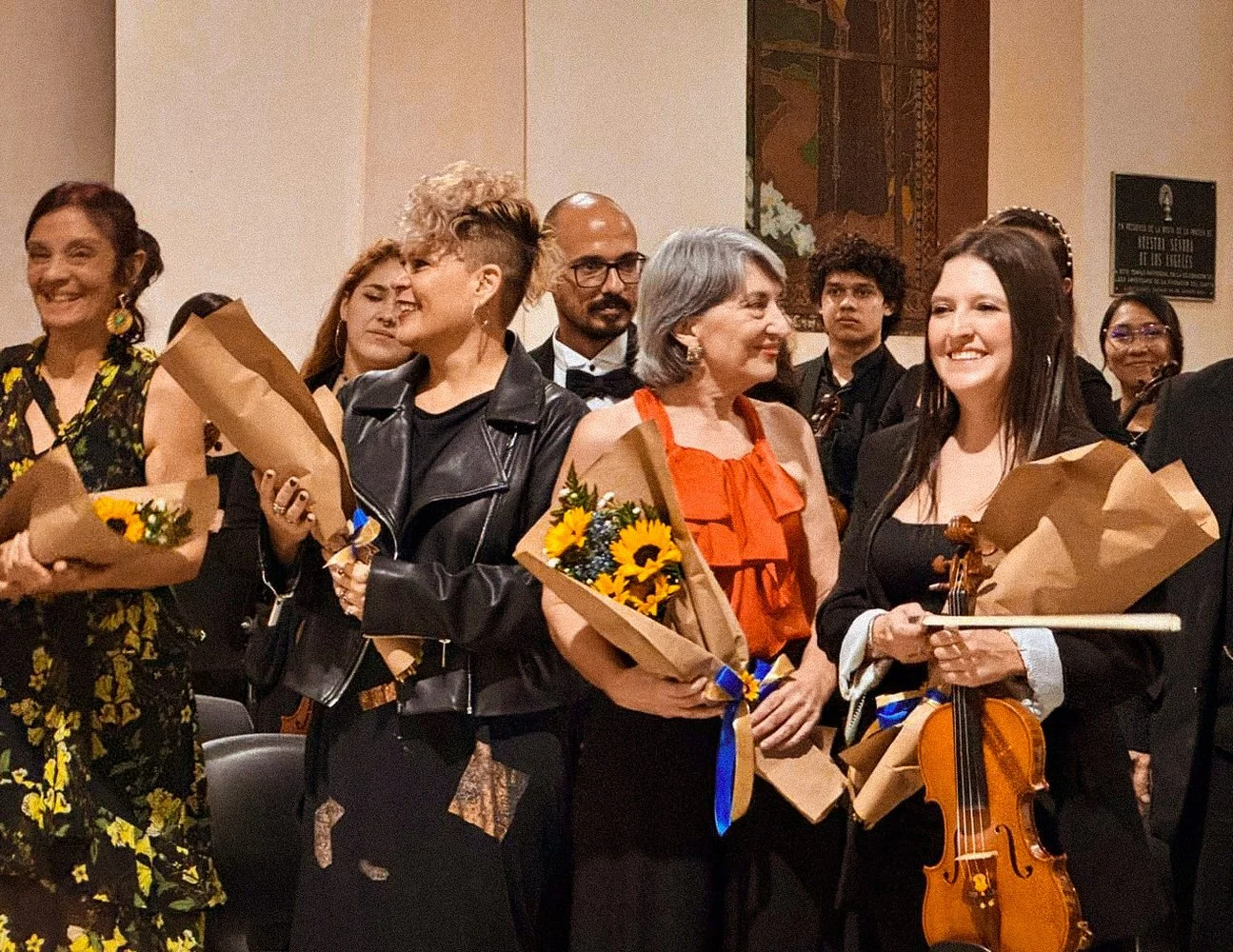← Return to LAB
Susan Campos—Fonseca:
La Creación sin mañana
Release: Feb 07, 2025
Irreverence Group Music [IGM] proudly presents the live recording of Campos—Fonseca’s La Creación sin Mañana, marking its second performance.
Originally commissioned in 2021 by Alejandro Gutiérrez—Mena, principal conductor of the University of Costa Rica Symphony Orchestra (OSUCR), and harpsichordist María Clara Vargas—Cullell, La Creación sin Mañana was composed for harpsichord with a Noise Machine (soloist), two trumpets, four horns, piano, string orchestra, and percussion ensemble. Conceived in the midst of the COVID-19 pandemic, the work premiered at the National Theater of Costa Rica on August 9, 2021, and was later published in Campos—Fonseca’s album La Venganza del Agua [IGM, 2022].
Listen to La Creación sin Mañana
La Creación sin mañana
-
Format: Single
Release: February 07, 2025
Catalogue: IGML-009
GTIN/EAN/UPC: n/a
Producer: IGM
Commissioned by OSUCR -
María Clara Vargas (Harpsichord)
Sharon Villegas—Fernández (Piano)
Alejandro Gutiérrez—Mena (Conductor)
Orquesta Sinfónica de la Universidad de Costa Rica -
Susan Campos—Fonseca
-
Albert Camus, The Myth of Sisphus (1942)
-
Campos—Fonseca — La Creación sin Mañana
01. La Creación sin Mañana
-
Commissioned by OSUCR
Produced by Irreverence Group Music
Music by Susan Campos—FonsecaMaría Clara Vargas (Harpsichord)
Sharon Villegas—Fernández (Piano)
Alejandro Gutiérrez—Mena (Conductor)
Orquesta Sinfónica de la Universidad de Costa RicaRecorded, mixed & mastered
by Felipe Fernández
at Cyancoco Studio, San José,
Costa Rica
Video by José María Piedra,
Manuel Carazo & Felipe Fernández
Edited by José María PiedraAlbum Notes by Susan Campos—Fonseca
Artwork/Cover: IGM
Photography by Ricardo Cambronero
Ⓟ & © IGM 2025

Composer's NOTES
La Creación sin mañana (Revised Version 2024)
By Susan Campos-Fonseca
"The very struggle toward the heights is enough to fill a heart."
—Albert Camus, The Myth of Sisyphus (1942)
In 2021, Alejandro Gutiérrez—Mena, principal conductor of the University of Costa Rica Symphony Orchestra (OSUCR), and harpsichordist María Clara Vargas—Cullell commissioned me to compose a work for harpsichord and orchestra. The score for La Creación sin Mañana, written for harpsichord with a Noise Machine (soloist), two trumpets, four horns, piano, string orchestra, and percussion ensemble, was conceived in the midst of the COVID-19 pandemic. It premiered at the National Theater of Costa Rica on August 9, 2021, and was later published in my album La Venganza del Agua IGM, 2022. At that time, I wrote:
"To contemplate loops of shadow and impermanence—that is my goal. The piece is composed of ten modules, each a loop capable of interweaving with the others, regardless of the order in which they are performed. The graphic notation of the sonic matrices that form these modules is based on the works of minimalist painter Agnes Martin (1912–2004). The orchestration draws from Henryk Mikołaj Górecki, Morton Feldman, Pauline Oliveros, and Eliane Radigue, reflecting on the residual sounds of the tonal regime, whose memory lingers in the technology of the harpsichord and the ‘well-tempered system.’ Consequently, the work's DNA includes the ‘unmeasured’ preludes and sarabandes of Élisabeth Jacquet de La Guerre (1665–1729). To deconstruct these remnants, the soloist’s improvisations are combined with a Noise Machine [manufactured by DLP Electronics Bolivia/Argentina] and free transcriptions of NASA’s sonification of data obtained from the magnetosphere. The piece’s aesthetic can be placed within instrumental musique concrète and post-minimalism. Its purpose is to weave a collective ‘sonic meditation’ that contemplates, serenely, what Albert Camus understood as ‘the creation without tomorrow.’”
Susan Campos—Fonseca
& María Clara Vargas—Cullell
Photo by Jesús Salazar Brenes
My first focus was on the harpsichord’s sonic possibilities: fast, highly rhythmic passages alternate with slow, arpeggiated moments, where the instrument’s resonance is filled with harmonics. Dense, tightly clustered chords of three or four notes contrast with wide clusters spanning over an octave, requiring the use of the forearm and an exploration of the harpsichord’s various registers and tessituras.
— María Clara Vargas—Cullell
Rubia Santos,
Susan Campos—Fonseca,
María Clara Vargas &
Luisana Padilla
Photo by OSUCR
A new, thrilling, and powerful interpretation
Maestro Gutiérrez incorporated the work into OSUCR’s repertoire, and in 2024 it was programmed once again as part of the orchestra’s VIII Season Concert, titled Memory, Women, and Music, alongside works by historical female composers such as Ethel Smyth (United Kingdom, 1858–1944) and Amy Beach (USA, 1867–1944). The program also included a concerto by Camargo Guarnieri (Brazil, 1907–1993), performed by Brazilian pianist Rubia Santos, with Costa Rican guest conductor Luisana Padilla.
I decided to revise La creación sin Mañana in collaboration with the soloist, María Clara Vargas. The result was a new version of the work, premiered on November 1, 2024, at the Parish of San Antonio de Padua in the community of Curridabat, San José, Costa Rica’s capital. Regarding this new performance, María Clara wrote:
"At the beginning of 2024, Alejandro Gutiérrez, director of OSUCR, gave me the unexpected news that he would be programming La creación sin Mañana once again—a piece for harpsichord, noise machine, and orchestra, composed by Susan Campos—Fonseca. I was overjoyed to hear this because, although we had premiered the piece before, it had been during the pandemic. Moreover, knowing the composer, I was sure that this new staging would be an incredibly enriching experience for me as a performer.
Upon revisiting the piece, I set out to ‘forget’ everything from the first version and approach the score with a fresh perspective. My first focus was on the harpsichord’s sonic possibilities: fast, highly rhythmic passages alternate with slow, arpeggiated moments, where the instrument’s resonance is filled with harmonics. Dense, tightly clustered chords of three or four notes contrast with wide clusters spanning over an octave, requiring the use of the forearm and an exploration of the harpsichord’s various registers and tessituras.
The alternation of different hand and forearm positions led me to seek bodily movements that would clearly convey the energy and intensity of the piece. Finally, I had to explore the noise machines and develop a counterpoint between them and the harpsichord—an experience that was both challenging and full of surprises. All of this was in dialogue with the orchestra’s diverse instrumental textures.
As on previous occasions, one of the most satisfying aspects was having the opportunity to discuss my interpretative ideas with Susan, who was always open to my suggestions. Once we had finalized the version, we worked with Alejandro, whose attention to detail and precision were invaluable. The night of the concert, we achieved a complete immersion into the work: everything we had developed, combined with the orchestral sound and the acoustics of the Church of Curridabat, allowed us to create a new, thrilling, and powerful interpretation that both astonished and excited the audience."
With the support of Irreverence Group Music (NYC) and OSUCR, we are releasing this premiere with audiovisual production and a live recording by Cyancoco Studio (Costa Rica).
My deepest gratitude goes to Ernesto Rodríguez-Montero, director of the School of Music at the University of Costa Rica; pianist Sharon Villegas Fernández, co-soloist in this new version; conductor Ricardo Cambronero, assistant to Maestro Gutiérrez; and the entire OSUCR, whose sonic force shaped and sculpted this testament from those of us who survived the pandemic—I dare to call it a human biotechnological war—because through this strength and resilience, we pay tribute to all the victims (human and non-human) of the ongoing planetary struggle for life.
Susan Campos-Fonseca, PhD
Composer
About the author
Campos—Fonseca holds a Ph.D. in music from the Universidad Autónoma de Madrid (UAM), Spain. Master in Spanish and Latin American Philosophy from the Universidad Autónoma de Madrid (UAM), and graduated in Conducting by the Universidad de Costa Rica (UCR). She is a composer and musicologist whose research focuses on philosophy of culture and technology, feminism, decolonial studies, electronic art and sound studies.
the OSUCR
University of Costa Rica Symphony Orchestra [OSUCR]
Founded in 2009 as an institutional unit of the University of Costa Rica, the University of Costa Rica Symphony Orchestra (OSUCR) is one of the country’s most distinguished artistic organizations. Its mission is to project the cultural and artistic values of the UCR to Costa Rican society, offering high-impact experiences that promote cultural development, music education, and inclusive access to the arts.
OSUCR stands out as an innovative and dynamic space that nurtures the talent of new generations of professional musicians, many of whom are graduates of the UCR School of Musical Arts. Additionally, the orchestra is committed to cultural decentralization, bringing its productions to diverse communities across the country.
Recognized with the 2019 Carlos Enrique Vargas National Music Award, among other public distinctions, OSUCR has solidified its reputation for artistic excellence. Under the artistic direction of Maestro Alejandro Gutiérrez, the orchestra continues to expand its cultural influence, performing a repertoire that spans from the most iconic classical works to contemporary compositions by living composers. OSUCR is dedicated to breaking paradigms and expanding the boundaries of symphonic music in Costa Rica.
As part of the University of Costa Rica, OSUCR not only enriches the country's cultural landscape but also integrates into educational and research processes, serving as a living example of the profound impact that art can have on modern society.




